In which we embark on our journey and start planning our fortress.
We can embark on our journey right now, or we can take our time and prepare for it. If we leave right now, we get a predefined skillset for our dwarves and a semi-random set of goods. The list can be found over at the wiki, which also states that this option is “no more doomed than any other embark”. We, however, will prepare for our journey carefully.
We get 1,274 embark points to buy skillpoints for our dwarves and goods to take with us. Skillpoints become more expensive the better the skill gets, and a dwarf can only be given ten skillpoints in total with a maximum of five in a given skill. Leaving with lower or unskilled dwarves is totally possible and maybe I’ll do it sometime, for the lulz. Skilled dwarves work faster and produce higher quality goods, and skilled miners have a higher chance of mining usable gems or ores out of veins.
We leave our mountainhome with two miners (with the mining skill at 5/5), a woodworker (wood cutting and carpentry at 4, axedwarf at 1), a mason (mason 5, mechanic and building designer at 1), a farmer (planting 5, brewing and cooking 2), a hunter (crossbowdwarf and sneaking 2, butcher and tanner 1, wrestling 1), and a doc/trader/record keeper. This is by no means an ideal build, but it is the one I deemed usable late at night while slightly drunk. The wiki holds more information on starting builds, and for something more reasonable you should look there.
Supplies are a lot easier to screenshot:
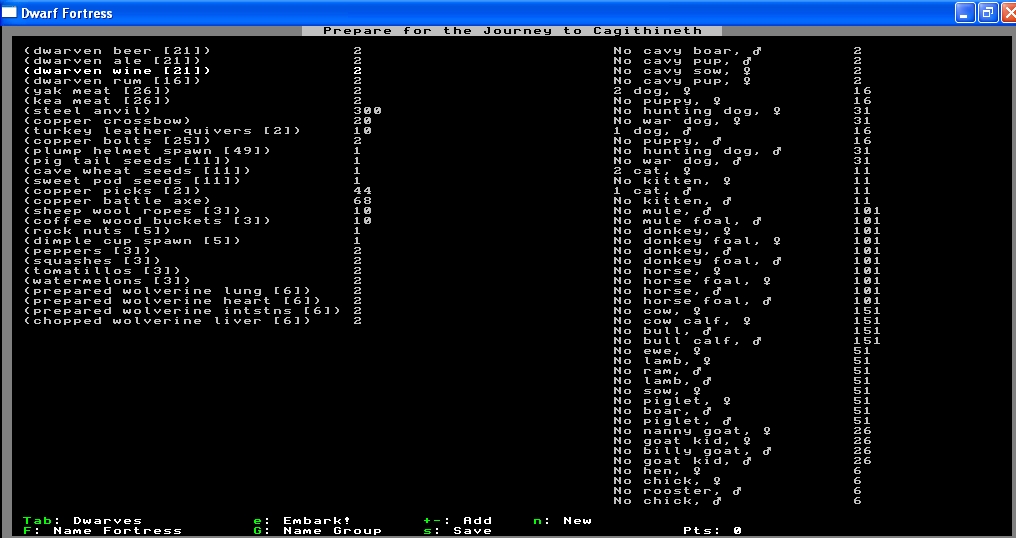 If you don’t know what you’re doing: pack a pick or two, an axe, and booze. The aforelinked wiki article about starting builds holds more about different ways to pack, but this is how we roll.
If you don’t know what you’re doing: pack a pick or two, an axe, and booze. The aforelinked wiki article about starting builds holds more about different ways to pack, but this is how we roll.
We can also choose to pick a name for the new fortress and one for our ragtag band of misfits leaving for it.
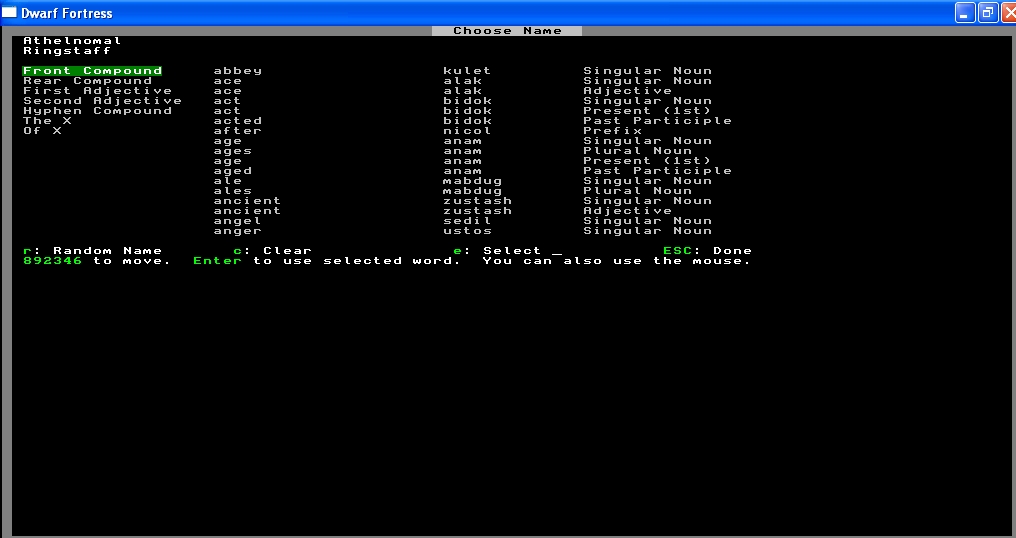 You can get whatever you want of this extensive library of the dwarven language, I usually just hit “random” until something good comes up – the dwarves of The Oaken Hammer shall make their way towards Ringstaff, their new home.
You can get whatever you want of this extensive library of the dwarven language, I usually just hit “random” until something good comes up – the dwarves of The Oaken Hammer shall make their way towards Ringstaff, their new home.
I probably missed the potential for some extraordinary bad jokes here, but they will have to wait for another pass.
Having finished all the preparations, it’s time to hit the road.
We arrive at our destination in the middle of nowhere, with us a single cart containing all our stuff and our bunch of seven dwarves, looking for a new home.
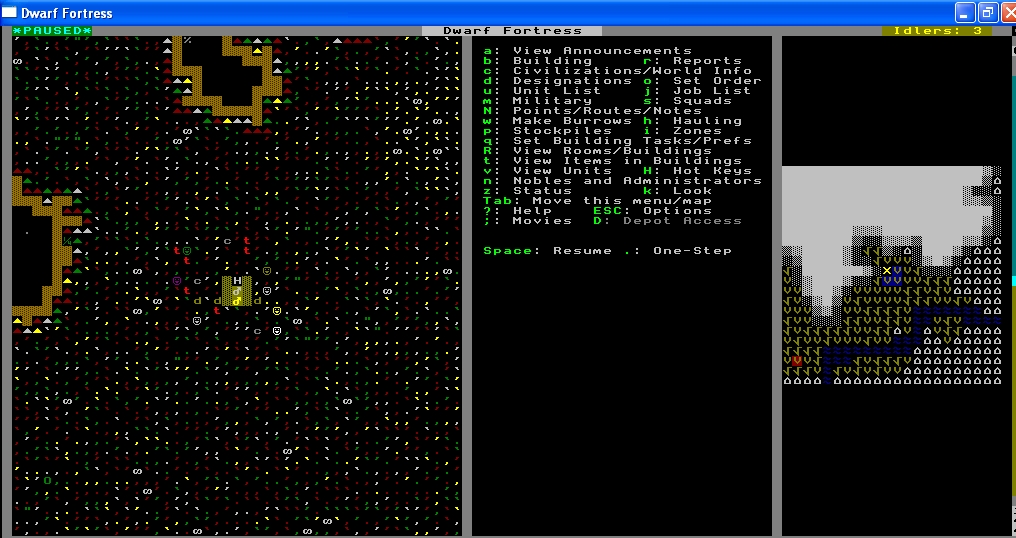 Left side game screen, menu in the middle, right side minimap.
Left side game screen, menu in the middle, right side minimap.
In the middle of the game screen we see the wagon we arrived with, surrounded by our dwarves and the livestock we brought with us.
On the minimap we see the river. Green is usually an area where things grow (grass or woodland), grey is stony ground, massive grey is mountainside. The assorted colourful accents and punctuation marks are ground, bushes, shrubs, and the like, the infinity-signs are boulders. Upward triangles are upward ramps, downward triangles would be downward ramps. Black tiles are underground, the greenish walls are clay walls. The “O” in the lower left edge is a tree, or on this map, a cactus. Yes, we’re in cactus-land. With the 2014-version of DF trees began to grow over several z-levels, complete with crowns – in earlier versions trees were just one-tile plants. On this map we have at least one cactus growing over 11 z-levels.
On the lower edge we usually would see announcements, on the right side we should see the z-level indicator. Here is a screenshot from the not-maximized game window, where all edges are clearly visible:
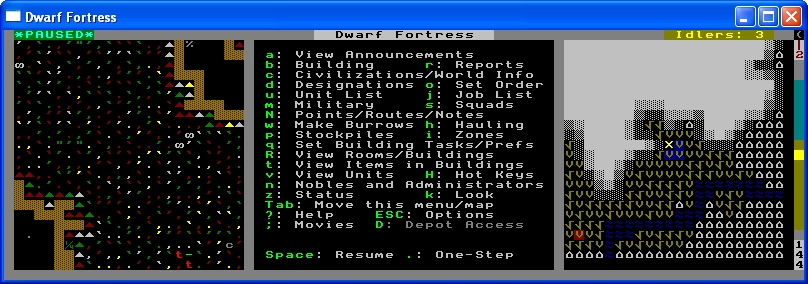 I’ll probably take fullscreen shots except when I want to illustrate something stretching along several z-levels to show an announcement.
I’ll probably take fullscreen shots except when I want to illustrate something stretching along several z-levels to show an announcement.
Before we start digging, I want to talk about Dwarf Therapist.
 While it is theoretically possible to assign the labours to your dwarves manually, don’t. This way lies madness. The Therapist gives us a clean overview over all occupations and an easy way to assign or remove jobs from dwarves. I usually strip essential industrialists from all hauling duty to stop my crafters from running around working in hauling. This kind of behaviour should be corrected by now, so I let the assignments be with the exception of the miners.
While it is theoretically possible to assign the labours to your dwarves manually, don’t. This way lies madness. The Therapist gives us a clean overview over all occupations and an easy way to assign or remove jobs from dwarves. I usually strip essential industrialists from all hauling duty to stop my crafters from running around working in hauling. This kind of behaviour should be corrected by now, so I let the assignments be with the exception of the miners.
Now it is time for our first designations.
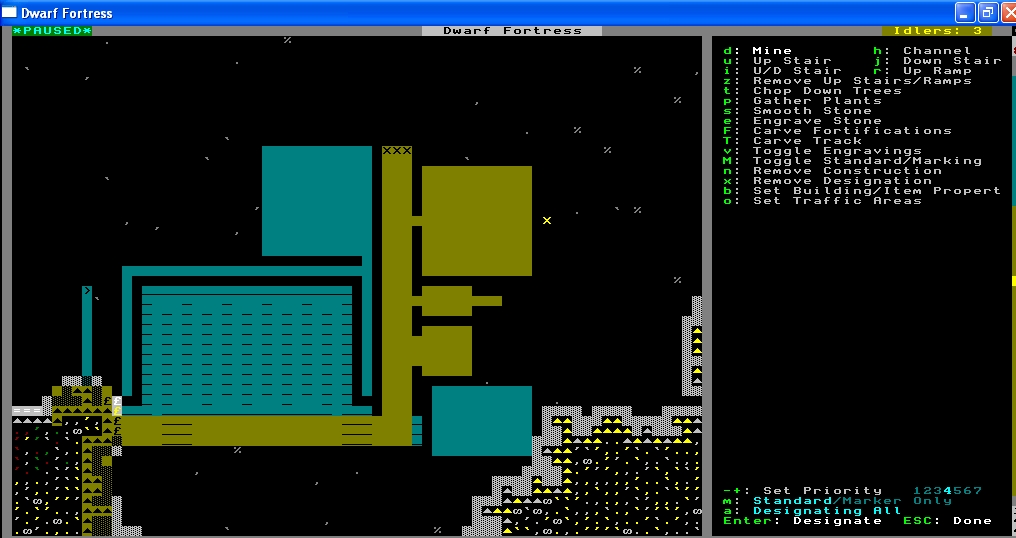 Green is “dig now”, blue-ish green is “here we dig later”.
Green is “dig now”, blue-ish green is “here we dig later”.
We clear a bit of mountain around our chosen entrance and dig one. Along the main hallway we dig two channels. These will be enhanced by bridges. Our goal is to send intruders along the winding path, which we will litter with traps – intruders can evade forward into the next trap, backward, or left or right into the abyss. We’ll also construct a fortified position for a squad of crossbowmen, to inflict further harm.
On the far end of the corridor we will build a ballista-emplacement.
Around the corner we will construct 5×5-room for the trade depot, a 3×5-room for a dormitory with a 3×1-appendix for a basic office for our bookkeeper, and a depot of 11×11 tiles, to get our stuff out of the rain sun.
The x-es at the end are stairways in both z-directions. “>” is a downward stairway, “<” an upward stairway.
I really like the new marker feature for designations. If one wanted to mark areas for later digging in older versions, the only option was a regular designation – and be damn careful not to have any designated tile reachable for your miners, or they would go for it the second the algorithm told them to. The old mining job algorithm worked in 16×16-squares, over z-levels. So one job would be temporarily abandoned for another job on a different level. Even if this isn’t fixed yet (I’ve no idea whether or not it is), the assignment of priorities to designations should at least reduce the amount of involuntary fun. Oh, and we now can designate areas for mining everything, mining ore and gems or only gems, or *drumroll* automining veins of ore or clusters of gems.
We also order the chopping of some cacti to get some wood and finally unpause the game for the first time…

